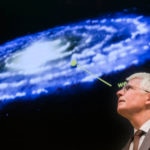Invisible light to look for dark matter
Dark matter is not black. It is, actually, invisible. It is also everywhere – it is estimated to account for 27% of the universe’s total mass-energy density – but we cannot see it because it is too cold and does not emit any radiation. It is completely different from anything we know. And to find it, an invisible light is needed: Cherenkov’s radiation. It is no wonder that the telescopes trying to detect it are called MAGIC.

Nights would not be so dark if our eyes were more sensitive. We would be able to see a display of blue lights generated by the myriad of gamma rays that shower atmosphere every second, a phenomenon known as the Cherenkov radiation. “A beam of blue light similar to a car’s headlight that telescopes use to take an image of them and determine in which direction they point at,” explains Werner Hofmann, Director of the Max Planck Institute for Nuclar Physics, who visited Madrid to offer a conference in BBVA Foundation.

Werner Hofmann, Director of the Max Planck Astrophysics Institute, visited Madrid to offer a conference in BBVA Foundation
This light, which is invisible to our eyes – but which can be detected by a range of gigantic telescopes named after the light they try to detect – can guide us toward dark matter. Accurately capturing this flash of light, which is like a high-speed and extremely weak shooting star, requires extremely ample detection areas. For this reason, the Cherenkov Telescope Array (CTA) has been designed, which will span over two observatories, one in each hemisphere. Each one of them will consist of dozens of different size telescopes (23, 12 and 4 meters in diameter).
The northern hemisphere observatory will be located in Roque de los Muchachos, in the Spanish Island of la Palma. The southern hemisphere observatory will be erected in the Atacama desert, Chile. Both locations will allow to scan the entire sky and will double de existing capacity for detecting rare phenomena, such as gamma ray explosions.
How can we determine whether dark matter exists?
The matter we know, and which makes everything that surrounds us – Earth, the Sun, other planets and stars, even all things alive – only represents 5% of the Universe’s total content. We can see this matter because it emits photons (light). The rest of the universe is made up by the mysterious dark matter (27%) and by the even more elusive dark energy.

Gabriel Pérez Díaz, Instituto de Astrofísica de Canarias
Dark matter – thus called not because of its color, but because, as it does not emit photons, it is invisible – can be detected indirectly thanks to its effect in the remaining celestial objects: for example, in the movement of the stars in our galaxy. In fact, it seems that it was dark matter that forced ordinary matter to form the first stars in the primitive universe.
Many physicians also argue that, when dark matter particles collide they annihilate each other to produce gamma rays. Precisely, at the heart of the Milky Way, there is an unknown source of gamma rays that may be the result of a high concentration of dark matter particles colliding and annihilating each other.
“The Cherenkov Telescope Array, which will start operating in 2021 will be ten times more sensitive than current instruments and will either be capable of capturing the annihilation of dark matter particles or will allow us to discard these models,” said Werner Hofmann.